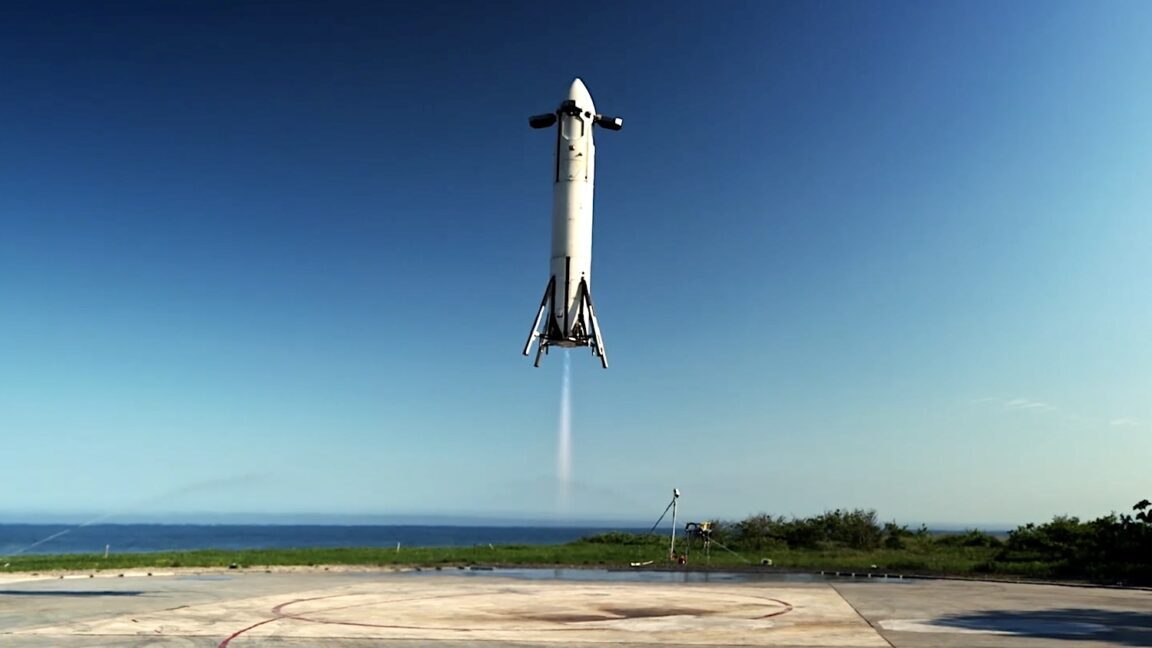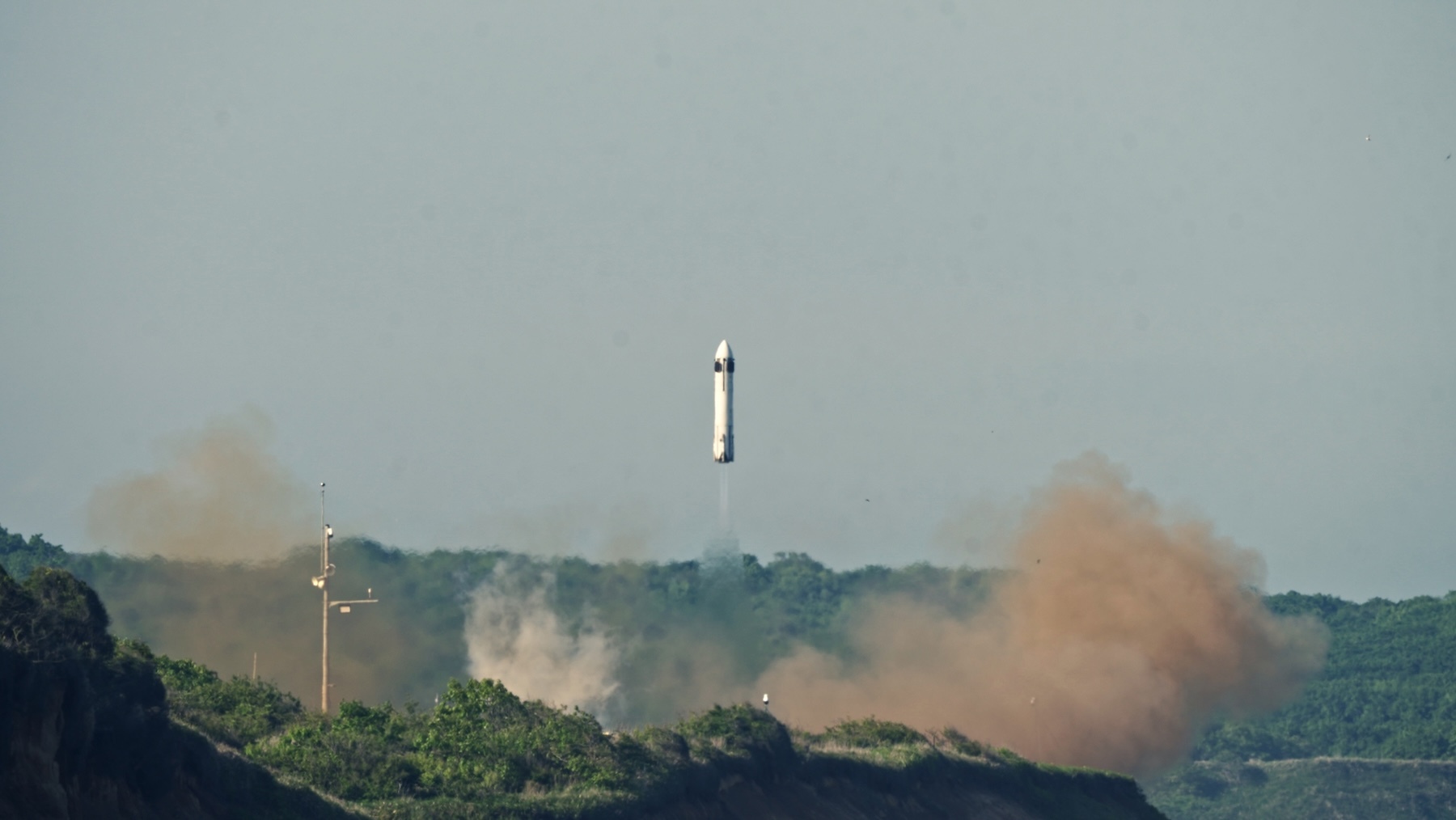20.06.2025
Car companies aren't accustomed to making vehicles that can only be used once.

Honda's rocket hopper descends toward a vertical landing Tuesday. The rocket's faint blue-orange engine plume might suggest it burns liquid methane fuel. Credit: Honda
An experimental reusable rocket developed by the research and development arm of Honda Motor Company flew to an altitude of nearly 900 feet Tuesday, then landed with pinpoint precision at the carmaker's test facility in northern Japan.
The accomplishment may not sound like much, but it's important to put it into perspective. Honda's hopper is the first prototype rocket outside of the United States and China to complete a flight of this kind, demonstrating vertical takeoff and vertical landing technology that could underpin the development of a reusable launch vehicle.
While Tuesday's announcement by Honda was unexpected, the company has talked about rockets before. In 2021, Honda officials revealed they had been working on a rocket engine for at least two years. At the time, officials said a small satellite launch vehicle was part of Honda's roadmap.
The rocket Honda talked about in 2021 could put a payload of up to 1 metric ton into low-Earth orbit. It's unclear whether Honda is still targeting this sector of the launch market. Company officials then committed to supporting internal development work until about 2025 or 2026, when it would make a "go" or "no go" decision on whether to finish the project and field an operational rocket.
Who saw this coming?
Honda has been quiet on the rocket project since a brief media blitz nearly four years ago. That changed Tuesday, when Honda announced the successful launch and landing test of an experimental reusable rocket.
Developed in-house by Honda R&D Company, the rocket climbed vertically from a pedestal at the company's test site in southeastern Hokkaido, the northernmost of Japan's main islands. The vehicle reached an altitude of about 890 feet (271 meters). The vehicle descended to a nearby landing target and settled on its four landing legs just 15 inches (37 centimeters) from its aim point, according to Honda.
What's more, the rocket stood on its four landing legs for liftoff, then retracted the landing gear as it climbed into the sky. At its highest point, the vehicle extended aerodynamic fins akin to those used on SpaceX's reusable Falcon 9 and Super Heavy boosters. Moments before reaching the ground, the rocket folded the fins against its fuselage and deployed its four landing legs for touchdown. The flight lasted approximately 57 seconds.
In a statement, Honda said this first launch and landing test demonstrated "key technologies essential for rocket reusability, such as flight stability during ascent and descent, as well as landing capability." Honda said the rocket performed as expected, and it released a video of the test flight, which is embedded below.
The test rocket is small in stature, measuring less than 21 feet (6.3 meters) tall and about 2.8 feet (85 centimeters) in diameter. Fully fueled, the rocket weighed about 2,892 pounds (1,312 kilograms). Honda has been reticent about the rocket's engines, but the company's video of the test flight suggests the liquid-fueled engines consume cryogenic propellants, possibly a mixture of methane and liquid oxygen.
This is new territory for Honda, but the carmaker has remade itself multiple times since its founding as a motorcycle company in 1946. Honda expanded into automobiles in 1963, then its research and development subsidiary—the same one now working on rockets—secretly started designing an airplane in 1986. The confidential project produced HondaJet, a light business jet that made its first flight in 2003. Pilots and owners have generally favorable reviews for the newest versions of HondaJet.
"We are pleased that Honda has made another step forward in our research on reusable rockets with this successful completion of a launch and landing test. We believe that rocket research is a meaningful endeavor that leverages Honda’s technological strengths," Toshihiro Mibe, global CEO of Honda, said in a press release.
"Honda will continue to take on new challenges—not only to offer our customers various services and value through our products, while addressing environmental and safety issues, but also to continue creating new value, which will make people's time and place more enjoyable," Mibe said.
Other space projects with Honda involvement include a pressurized crewed Moon rover developed in partnership between Japan's space agency and Toyota. Honda has agreed to supply the rover with a renewable energy system for continuous production of oxygen, hydrogen, and electricity from sunlight and water.
Go or no go?
Honda said its launch vehicle is "still in the fundamental research phase," and the company has made no decision whether to commercialize the rocket program. Nevertheless, Honda says it's on a path toward conducting a suborbital launch by 2029.
The company has not disclosed its spending on rocket development. Honda's hopper is smaller than similar prototype boosters SpaceX has used for vertical landing demos, so engineers will have to scale up the design to create a viable launch vehicle.
But Tuesday's test catapulted Honda into an exclusive club of companies that have flown reusable rocket hoppers with an eye toward orbital flight, including SpaceX, Blue Origin, Stoke Space, and a handful of Chinese startups. Meanwhile, European and Japanese space agencies have funded a pair of reusable rocket hoppers named Themis and Callisto. Neither rocket has ever flown, after delays of several years.

Honda's experimental rocket lifts off from a test site in Taiki, a community in northern Japan.
Before Honda's leadership green-lit the rocket project in 2019, a group of the company's younger engineers proposed applying the company's expertise in combustion and control technologies toward a launch vehicle. Honda officials believe the carmaker "has the potential to contribute more to people's daily lives by launching satellites with its own rockets."
The company suggested in its press release Tuesday that a Honda-built rocket might launch Earth observation satellites to monitor global warming and extreme weather, and satellite constellations for wide-area communications. Specifically, the company noted the importance of satellite communications to enabling connected features in cars, airplanes, and other Honda products.
"In this market environment, Honda has chosen to take on the technological challenge of developing reusable rockets by utilizing Honda technologies amassed in the development of various products and automated driving systems, based on a belief that reusable rockets will contribute to achieving sustainable transportation," Honda said.
Toyota, Japan's largest car company, also has a stake in the launch business. Interstellar Technologies, a Japanese space startup, announced a $44 million investment from Toyota in January. The two firms said they were establishing an alliance to draw on Toyota's formula for automobile manufacturing to set up a factory for mass-producing orbital-class rockets. Interstellar has launched a handful of sounding rockets but hasn't yet built an orbital launcher.
Japan's primary rocket builder, Mitsubishi Heavy Industries, is another titan of Japanese industry, but it has never launched more than six space missions in a single year. MHI's newest rocket, the H3, debuted in 2023 but is fully expendable.
The second-biggest Japanese automaker, Honda, is now making its own play. Car companies aren't accustomed to making vehicles that can only be used once.
Quelle: arsTechnica
